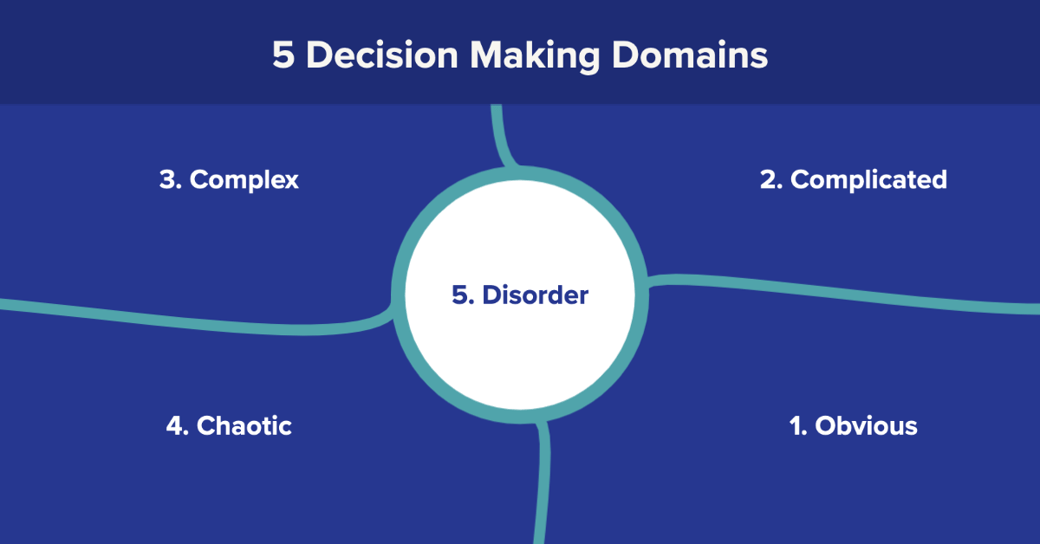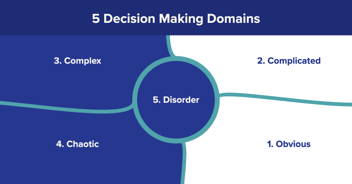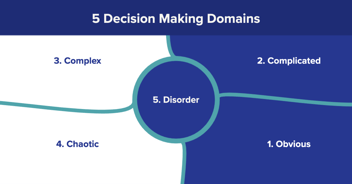Insights
Is AI the Right Solution to Your Business Problem? Part 3
The first two parts of this three-part series discussed classifying business problems according to their complexity. Part 1 discussed the domains associated with obvious and complicated problems, and Part 2 discussed the domains related to complex and chaotic problems. In this final installment, we discuss the disorderly domain and the value of conducting user experience research and data science. The following table displays problem types, their respective domains, and examples.
| Problem Type | Domain |
Example |
| Obvious (clear or simple) | Best Practice | Accounting |
| Complicated | Expert | Decision Support Systems |
| Complex | Emergence | Predicting Stick Prices |
| Chaotic | Rapid Response | Threat Analysis and Protection |
| Disorder | Lack of clarity—gather more information | Any problem not readily categorized into the other four |
As discussed previously, the problem types become increasingly disordered as we read the table from top to bottom, each requiring increasingly more robust solutions to match.
Solving disordered business problems
The fifth type of problem space is not just chaotic but completely disordered. Think of this space as the “black hole” of problem-solving, so disordered it is something perhaps has never happened before, and maybe never will. It’s not just a one-time event but probably a theoretical possibility. Under the proper conditions, an obvious, complicated, complex, or chaotic environment can devolve into a disordered one at any time. Sometimes, the incorrect action on the part of leaders or managers can propel such problems into the disordered domain. Hence, the importance of understanding which problem domain is under consideration and having an assortment of robust approaches at the ready to resolve it.
Dig deeper into understanding your business problem
Digging deeper into understanding your business problem is essential to selecting the proper solution. Sometimes, searching deeper requires leaders and managers to be open to change, even on a personal level. Managers must learn to identify the given context and change their behavior and decisions accordingly. Adept leaders facilitate their employees in understanding changing contexts and conditions and how to transition between them. What are you doing today to prepare your firm members for the diversity of contexts awaiting you in the future?
The recent pandemic offers an interesting example of the importance of leadership’s ability to manage multiple contexts at once. Leaders were called on to stem the initial panic by keeping the public informed (chaotic), keeping the government running smoothly (simple), call in experts (complicated), and continue to calm the communities in the months following the initial outbreak (complex). As can be observed, this last situation is proving to be the most challenging. Citizens are both afraid to get vaccinated and not. Some parents are scared to allow their children to show up at school, and workers are nervous about their workplace’s safety concerns.
A leader who misreads the context as simple might merely encourage the public to “carry on,” which does not reassure community members. Misreading the situation as complicated might well result in calling in experts to say things were safe—such behavior by itself could risk trust and credibility. Instead, good leaders in this situation are more likely to set up a series of events where all interested parties can share concerns and learn the facts. The correct approach in such a complex context allows, in part, for solutions to emerge from members of the community, rather than simply imposing them on the public.
Is it a user experience problem, after all?
It’s sometimes the case that perfect knowledge may be assumed. However, in many cases, the knowledge you already have might not comprise the entire story. Often, when a room full of experts convenes to discuss and compare notes, they create an exchange of information and share tacit knowledge. Think about the parable of the blind men and the elephant. As each person starts sharing information, each one gets closer to a complete picture. Sometimes even a complex problem, when deeply researched and redesigned, can turn into a complicated or obvious one—provided you spend the appropriate amount of effort in understanding the problem, collecting the correct data, and using the right strategy. Simplifying the problem often requires digging deeper to gather important information from the users who are often experiencing it first-hand.
Today’s greater complexity suggests when organizations encounter less familiar waters, their leaders need approaches and tools to guide them through. Natural leadership capabilities such as charisma, intellect, and intuition may not be sufficient in the face of increasing complexity. Leaders may even find they may be asked in certain situations to go against their instincts, either by sharing power or wielding it alone, as the situation calls.
Behavioral and data scientists work in tandem with people and data, using complementary research methods to achieve their goals. They may be performing ethnographic research, designing surveys, and conducting onsite interviews. They may be collecting, analyzing, modeling, and visualizing related data. They may or may not be using AI or machine learning in the process of solving the problem at hand. Experience professionals stand ready at the front lines—at the human-computer interface—armed with powerful research methods and analytical tools to get results. They work closely with business managers and leaders to understand the problem space and match the correct solution to the business’s problem.
Except for genuinely disordered problems, which at their heart are unsolvable, every other type of business problem today requires advanced computer power and resolution tools. And with those tools comes the need for solid user experience research, design, and data science. Managers require solutions that match the user’s mental model of how things should work and solutions that address their identified pain points. Discovery research enables all involved parties to feel confident they are collecting and analyzing the appropriate amount of good data, ensuring that the recommended solutions are based on a solid foundation. Part of that research includes understanding the business problem and boiling it down to its fundamental components. Doing this deep work upfront will prevent leaders and managers from spending resources on a heavy-duty mallet to smash the fly of a problem they may actually have.
What kind of business problem do you have?
Understanding the type of business problem you have is only the first step. Contact our team to help decide if AI and machine learning are needed to solve your business’s issues.



